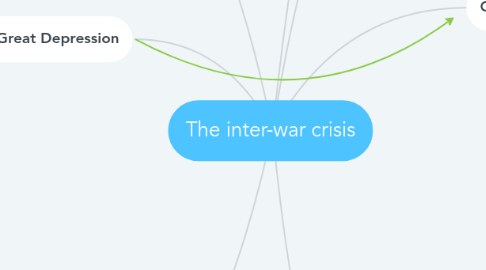
1. Post-war crisis
1.1. Material destruction +Deaths
1.1.1. Reduction of work-force
1.2. End of war economy
1.2.1. Military equipment
1.3. Shortage of food
1.3.1. Inflation (Germany)
1.4. US
1.4.1. First to recover
1.4.1.1. Loans to Europe
1.5. Mid 20s
1.5.1. Economy recovered
2. The Great Depression
2.1. Overproduction
2.1.1. Companies couldn't sell products
2.1.1.1. Bankrupt
2.1.1.1.1. Had to close
2.2. Falling consuption
2.2.1. People lost jobs
2.2.1.1. Stopped spending money
2.3. Wall street crash
2.3.1. companies in stock markets
2.3.1.1. began fail
2.3.1.2. Inventors panicked
2.3.1.2.1. Started selling shares
3. Democratic states
3.1. States
3.1.1. Great Britain
3.1.1.1. Parliamentary government
3.1.2. France
3.1.2.1. Republic
3.1.3. Germany
3.1.3.1. Weimar republic established
3.2. Not always protecting
3.2.1. Rights
3.2.2. Freedom
3.2.3. Equality
3.2.4. Worker's rights
3.2.4.1. Not respected
3.2.4.2. Reacted
3.2.4.2.1. Voted political parties
3.3. In response
3.3.1. Bourgeoisie and upper class
3.3.1.1. Voted Right-wing parties
3.3.1.1.1. Traditional
3.3.1.1.2. Conservatives politics
3.4. In Germany and italy
3.4.1. Some parties
3.4.1.1. opposed democracy
3.4.1.1.1. authoritarian regime
4. Economy
4.1. 1920
4.1.1. Economic prosperity (The roaring twenties)
4.1.1.1. 1929
4.1.1.1.1. Great depression
5. Politics
5.1. Democracy
5.1.1. Great Britain
5.1.2. France
5.1.3. US
5.2. Authoritarian dictatorships
5.2.1. USSR
5.2.2. Germany
5.2.2.1. Totalitarian regimes
6. Great depression
6.1. US
6.1.1. Ask countries
6.1.1.1. Pay loans
6.2. Consumption decreased in Europe
6.3. Companies
6.3.1. Went out of business
6.4. Wages fell
6.4.1. unemployment increased
6.5. Banks collapsed
6.5.1. People panicked
6.5.1.1. Took their money
6.6. Living standards
6.6.1. became worse
6.7. Protests against the government
6.7.1. Capitalist system
7. United States
7.1. 2 party political system
7.1.1. Republican party
7.1.1.1. Supported
7.1.1.1.1. Capitalism
7.1.1.1.2. Free markets
7.1.1.2. Opposed
7.1.1.2.1. Government intervene economy
7.1.1.3. Represents
7.1.1.3.1. Wealthy Americans
7.1.2. Democratic party
7.1.2.1. Supported
7.1.2.1.1. Capitalism
7.1.2.1.2. Government intervene economy
7.1.2.1.3. Policies to reduce
7.1.2.2. Represents
7.1.2.2.1. Middle and working classes
7.2. 1920s and 1930s
7.2.1. republicans
7.2.1.1. Fear to comunism
7.3. 1933
7.3.1. democrats
7.3.1.1. Roosevelt and the new deals
7.3.1.1.1. Government intervention economy
7.3.1.1.2. Public-work programmes
7.3.1.1.3. Estabilishment
7.3.1.1.4. Assistance for farmers
